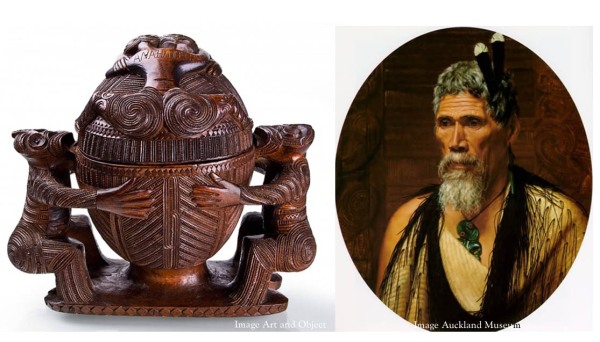
The kumete on the left showing the signature by Ngati Tarawhai chief Anaha Te Rahui whose portrait by Charles Goldie is on the right.
This kumete was carved by the great Anaha Te Rahui, chief of Ngati Tarawhai iwi in Rotorua area some time in the late 19thC . Anaha died in 1913 aged over 90 so his life covered a great swathe of significant NZ history. Roger Neich points out in Carved Histories that he began carving war canoes, then meeting houses as a part of the renowned Ngati Tarawhai school of carvers and ended producing tourist art. As well as this he was a war leader and a land assessor as well as claimant on behalf of his tribe and testified a great deal over many years so much is known about his life. In fact so much of his time was spent waiting about for the land court that Anaha used the time fruitfully to carve art works and generate some income. Charles Goldie painted his portrait not once, but twice. And there are many photographs of him which is a treat: I seldom know who made the items I work on so to have portraits, photographs and such an extensive biography is fantastic.
There are at least three almost identical kumete to this one. One in the Auckland Museum is known as “The Two Wrestlers” and is said to represent two chiefs fighting over tikitere (Hells Gate geothermal area in Rotorua). The other is in a Sydney museum. Another larger and more famous one is in the Field Museum Chicago. The box is unusual in that it is signed by the artist. Unlike the waka huia, which are carved on the bottom and made to be suspended in the air (containing huia feathers and other treasures) in a chiefs house, a kumete is a kind of storage container. The timber is, of course, the carvers favourite: totara. I always think of totara as the goldilocks timber as far as carving is concerned, it’s like a cross between kauri (too soft) and rimu (too brittle) – totara is just right.
What did I do to it? Very little: some minor repairs and reinstated the paua shell eyes which although fallen out over time. This kumete is illustrated in Roger Neichs Carved Histories and was featured in the recent Prime TV series History under the Hammer where it fetched $43,000 hammer price at Art and Object. As it was on TV I feel it is okay to put on the blog so it is in the public domain so to speak whereas much of my work , especially on waka huia, tekoteko and such like is usually private. I get a real satisfaction on working on Maori objects as it is the flip side of all the fine colonial objects I often work on. It also plays to my strengths regarding subtleties of surface, colour and texture. Usually the work relates to undoing previous clumsy attempts at restoration.
I hope I am not going to get myself into trouble here for use of these pictures. Obviously they are used for a non commercial purpose and I have attributed the pictures as best I can. Perhaps some of my savvier friends will set me straight.
Books, my continuing mini book blog…
Appropriately I have just read Wira Gardiners Te Mura o Te Ahi: The Story of the Maori Battalion which was a great read. I had the much larger Nga tama Toa: The Price of Citizenship by Monty Soutar about C Company of the Maori Battalion as a companion which was good to refer to for lots of photos and detailed sidebars. On the audio side in the last couple of weeks I’ve listened to An Economist Gets Lunch by Tyler Cowen a liberal – but not dogmatic – economist who defends the role of economics inglobal food production. He has a gentle style, is extremely well travelled and loves ethnic food. He says many things like this: that the best place to get good French food at a reasonable price is…Tokyo. Best place in world for fish and chips: NZ because we have a lot of coastline and, and it is popular and competitive culinary tradition here. After that I needed some lightening up so finally listened to Bossypants by Tina Fey, she of the famous Sarah Palin impersonation during the 2008 US elections. This is her light autobigraphy. She was one of the chief writers for the brilliant Saturday Night Live for years so she can really string a sentence together and it’s very funny. For the past week however I have been churning my way through Les Miserables by Victor Hugo (which at 60 hours lengths gazumps the previous 40 hours length champion I listened to Mao by Jung Chang and Jon Halliday). It is a new translation so it is quite fresh in its style (and has been criticised for some of it’s sometimes modern phraseology) but I like it and it also has an excellent and renowned reader – which is just as well as if you are listening to a book for 60 hours the reader has to be top rank. So I am half-way through now, only 25 cds to go…I don’t think I will make it by Saturday when I attend the production of Les Miserables my daughter is in so I will have the ending spoiled for me. I will be fascinated to see how they can compress such a massive book (1900 pages in the original French) into a 2 and a quarter hour show. I also now have the book from the library so I can perhaps speed things up it will all Les Mis all the time!



